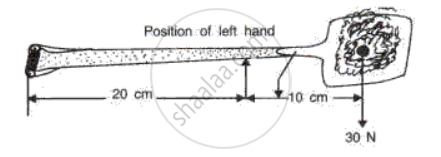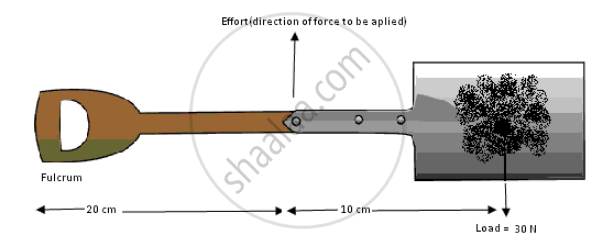Advertisements
Advertisements
प्रश्न
Fig. shows a spade. It is being used to lift soil weighing 30N from the ground.

(a) Mark the direction of the least force on the handle necessary to keep the spade balanced.
(b) Calculate the least force on the handle necessary to keep the spade balanced (the weight of the spade is negligible).
(c) If the left hand was move towards the soil on the spade, would the force on the handle necessary to keep the soil balance the greater or less? Give a reason for your answer.
(d) To which class of lever does the spade belong?
उत्तर
(a) Diagram showing the direction of application of least force on the handle:

(b) Given,load,L = 30 N
Let effort = E
Effort - arm = 20 cm
load - arm = 20 + 10 = 30 cm
Now, load x load - arm = effort x effort - arm
effort = `(30 xx 30)/20` = 45 N
(c) On moving the left hand towards the soil on the spade, the lenght of effort arm will increase and effort being inversely proportional to the lenght of effort arm, the force or effort necessary to keep the soil balanced would be less.
(d) A spade belongs to class III lever.
APPEARS IN
संबंधित प्रश्न
State whether the following statement is True or False.
In an ideal machine, work done on load is equal to the work done by effort.
Select the correct alternative:
For an ideal machine, the efficiency is
Name six simple machines. Give an example of each machine.
What do you understand by a simple machine?
Derive the relationship between mechanical advantage, velocity ratio and efficiency of a machine.
The mechanical advantage of an inclined place is always:
(a) less than 1
(b) equal to 1
(c) greater than 1
(d) nothing can be said
Write the relation between mechanical advantage, velocity ratio and efficiency.
Why is this so machines have to be maintained?
______ help us to make work easier.
Rearrange the letters and find out the name of the tool.

R L E V E
| ______ | ______ | ______ | ______ |
